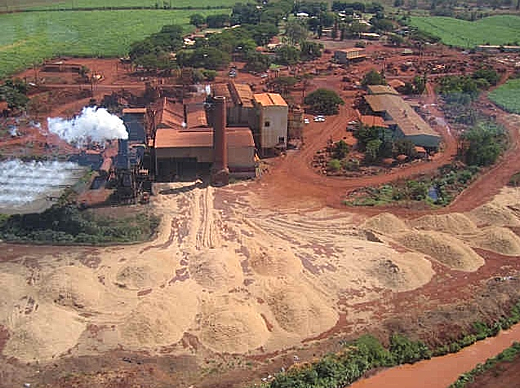SUBHEAD: What's most critical is that the state remain committed to its multi-pronged investment strategy.

Image above: Kaumakani Mill at the end of its production cane sugar. From(http://pacificwestenergy.com/aboutus.aspx).
By Editor on 3 July 2010 in Star Advertiser -
(http://www.staradvertiser.com/editorials/20100703_Ethanol_not_only_alternative.html)
It's hard to believe now, but ethanol was once touted as a hopeful big step into the brave new world of renewable energy, across the nation as well as in Hawaii.
The collapse in market prices for the fuel, as well as the high cost of land and permitting delays, diminished those hopes, in the islands especially. While viable ethanol production exists in other regions, the economics work out differently here and investor enthusiasm is waning.
As Star-Advertiser writer Alan Yonan Jr. chronicled Sunday, the roster of six plants initially envisioned as producers of ethanol has been winnowed to two.
According to executives of Pacific West Energy LLC, one of the last players standing, securing the acreage needed to start production has been the high hurdle to overcome. Signing a preliminary accord on a biomass plant -- which could broaden its revenue stream -- is a promising step, but success still hinges on land acquisition and other complications being cleared.
It's too soon to call it quits on biofuels, which are products of a young industry and still a work in progress. Research continues on commercially viable biodiesel from algae, which would be a feedstock requiring far less land.
And biofuels represent only a small part of the renewable-energy sector, in which Hawaii otherwise shows enormous potential. The islands already account for more than a third of all solar water-heating systems installed in the U.S., and work is under way to remake the state's electrical grid to accommodate more power produced by small-scale, non-utility sources, such as rooftop photovoltaic arrays.
Wind farms are becoming part of the present landscape, geothermal energy supplies about one-fifth of the Big Island's electricity needs and policymakers are in discussions over an undersea cable that could link renewable energy producers statewide with customers on Oahu.
On the consumption side, incentives supporting electric vehicle systems should further reduce dependence on fossil fuels, and a cooling system that will use seawater in downtown Honolulu air conditioning is in development.
The dream of innovation is that a single pursuit will yield a major element of Hawaii's energy solution. The reality is that achieving the state's goals of becoming far less dependent on fossil fuels is likely to look more like a jigsaw puzzle, at least until over time the most efficient and economical routes emerge.
What's most critical is that the state remain committed to its multi-pronged investment strategy. There's no way that remaining a remote state that's almost entirely dependent on oil imports makes sense for the long term. Breaking that stranglehold is too important to allow short-term potholes, like the ethanol frustrations, to discourage us.

Image above: Kaumakani Mill at the end of its production cane sugar. From(http://pacificwestenergy.com/aboutus.aspx).
By Editor on 3 July 2010 in Star Advertiser -
(http://www.staradvertiser.com/editorials/20100703_Ethanol_not_only_alternative.html)
It's hard to believe now, but ethanol was once touted as a hopeful big step into the brave new world of renewable energy, across the nation as well as in Hawaii.
The collapse in market prices for the fuel, as well as the high cost of land and permitting delays, diminished those hopes, in the islands especially. While viable ethanol production exists in other regions, the economics work out differently here and investor enthusiasm is waning.
As Star-Advertiser writer Alan Yonan Jr. chronicled Sunday, the roster of six plants initially envisioned as producers of ethanol has been winnowed to two.
According to executives of Pacific West Energy LLC, one of the last players standing, securing the acreage needed to start production has been the high hurdle to overcome. Signing a preliminary accord on a biomass plant -- which could broaden its revenue stream -- is a promising step, but success still hinges on land acquisition and other complications being cleared.
It's too soon to call it quits on biofuels, which are products of a young industry and still a work in progress. Research continues on commercially viable biodiesel from algae, which would be a feedstock requiring far less land.
And biofuels represent only a small part of the renewable-energy sector, in which Hawaii otherwise shows enormous potential. The islands already account for more than a third of all solar water-heating systems installed in the U.S., and work is under way to remake the state's electrical grid to accommodate more power produced by small-scale, non-utility sources, such as rooftop photovoltaic arrays.
Wind farms are becoming part of the present landscape, geothermal energy supplies about one-fifth of the Big Island's electricity needs and policymakers are in discussions over an undersea cable that could link renewable energy producers statewide with customers on Oahu.
On the consumption side, incentives supporting electric vehicle systems should further reduce dependence on fossil fuels, and a cooling system that will use seawater in downtown Honolulu air conditioning is in development.
The dream of innovation is that a single pursuit will yield a major element of Hawaii's energy solution. The reality is that achieving the state's goals of becoming far less dependent on fossil fuels is likely to look more like a jigsaw puzzle, at least until over time the most efficient and economical routes emerge.
What's most critical is that the state remain committed to its multi-pronged investment strategy. There's no way that remaining a remote state that's almost entirely dependent on oil imports makes sense for the long term. Breaking that stranglehold is too important to allow short-term potholes, like the ethanol frustrations, to discourage us.
.
No comments :
Post a Comment